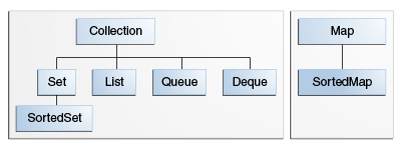Introduction #
This description is taken straight from Oracle’s Java Documentation page.
The Java platform includes a collections framework. A collection is an object that represents a group of objects (such as the classic Vector class). A collections framework is a unified architecture for representing and manipulating collections, enabling collections to be manipulated independently of implementation details.
Object-Oriented Fundamentals #
It would be helpful to remember that because is using the Java programming language, which is an object oriented programming language, these collections use the data abstraction concepts such as inheritance to make it possible to be used.
These collections are interfaces. In the Java language, interfaces come with certain rules of how it can be used. In order to inherit (or use an interface), you would use the keyword implement and you can do this as many times as your program needs. You can inherit if you’d like to define a certain object to have the properties of any interface.
You can also use one of the collections directly by invoking it, such as
ArrayList a = new ArryList();
Collections Available #
The available implementations are described in the Java Documentation
The way to read the table below… note that this table comes directly from the Java documentation page.
The first column describes the type of Java interface. The first row describes the possible data structures available. The cells with both row and column indicate the collection that has traits of both the column and row.
| Interface | HashTable | Resizable Array | Balanced Tree | Linked List | Hash+LL |
|---|---|---|---|---|---|
Set |
HashSet | TreeSet | LinkedHashSet | ||
List |
ArrayList | Linked List | |||
Deque |
ArrayDeque | Linked List | |||
Map |
HashMap | TreeMap | LinkedHashMap |
Set, List, Map, etc #
There are some extra keywords that Java uses that are important to know when using the Java Collections Framework.

| Interface | Duplicates Allowed? | Null Values Allowed? | Insertion Order preserved? | Iterator | Data Structure |
|---|---|---|---|---|---|
| List | Yes | Yes, Multiple null values allwed | Yes | Iterator, ListIterator | Array |
| Set | No | Yes but only once | No | Iterator | Underlying Map Implementations |
| Map | Not for keys | Yes, but only once for keys | No | Through keyset, value and entry set | Hashing Techniques |
Using Collections framework #
Section to be filled with examples
Slides #
References #
- The Java Collections Framework https://docs.oracle.com/javase/8/docs/technotes/guides/collections/
- The Java Tutorials: Collections https://docs.oracle.com/javase/tutorial/collections/index.html